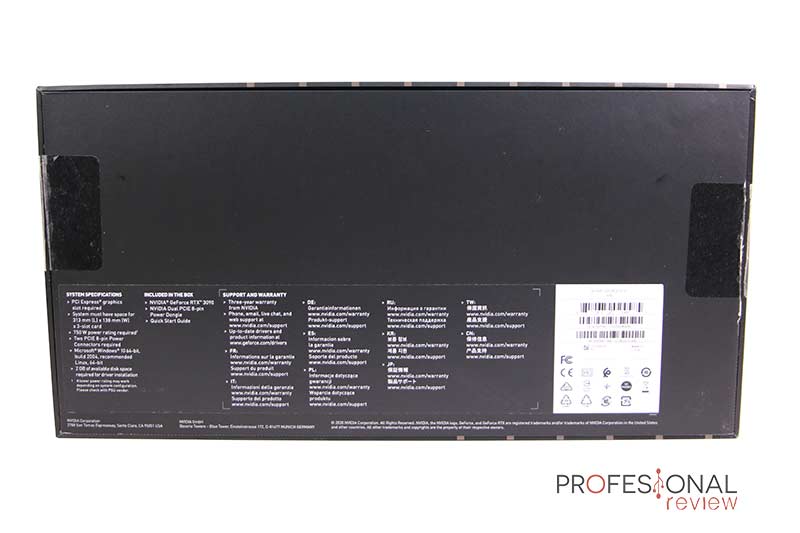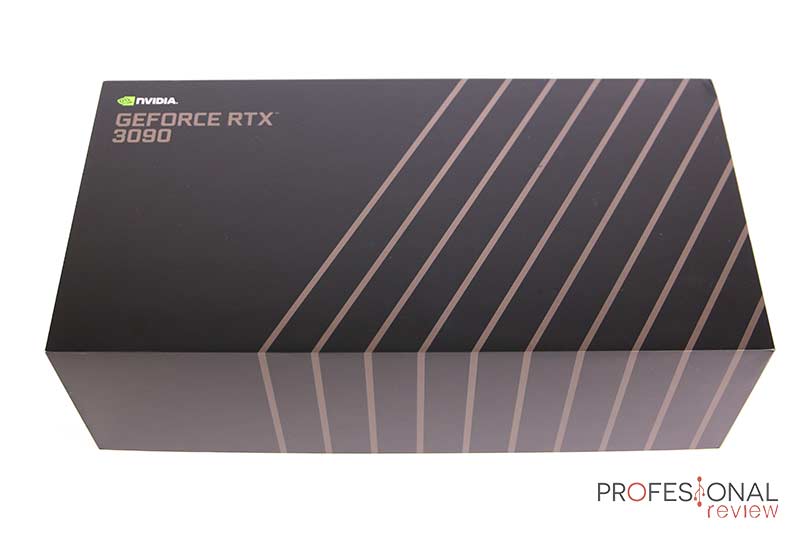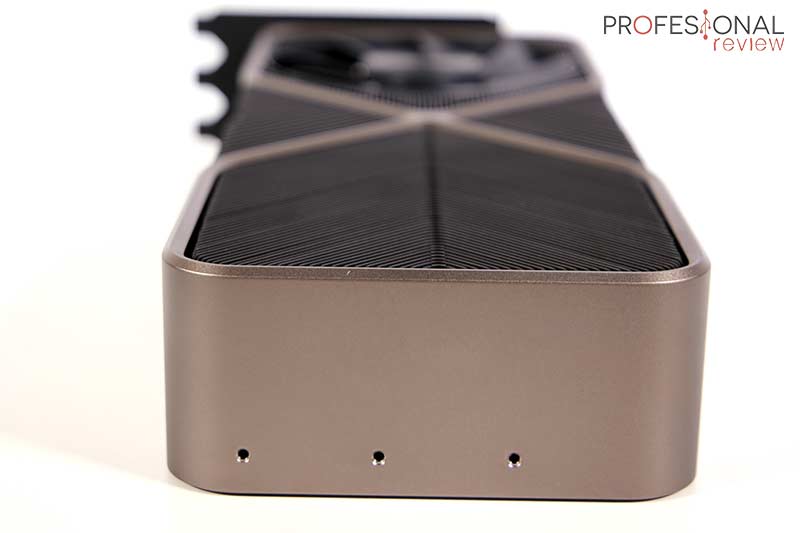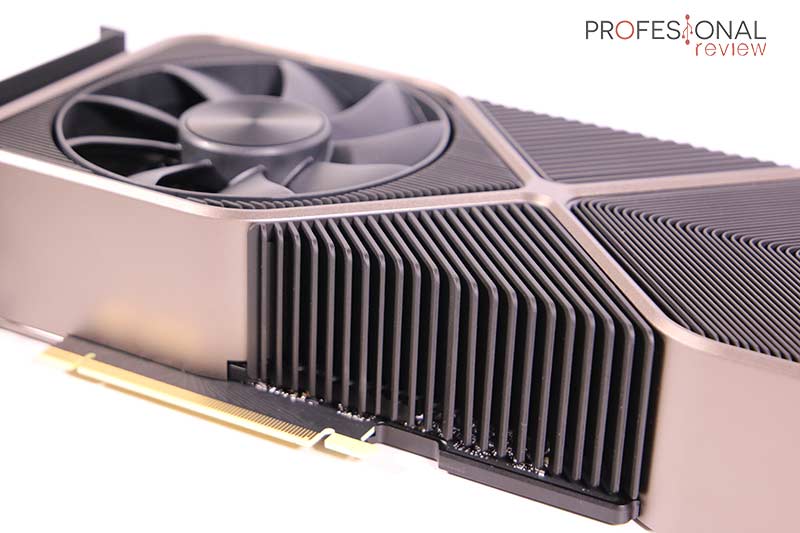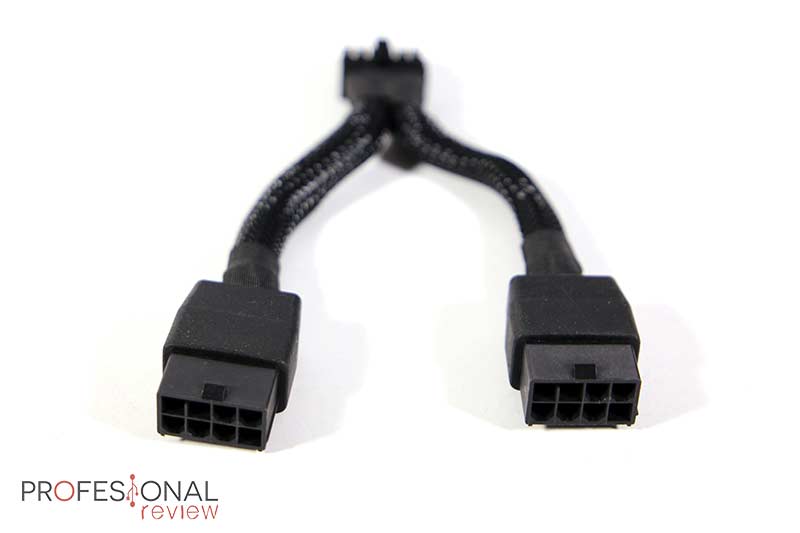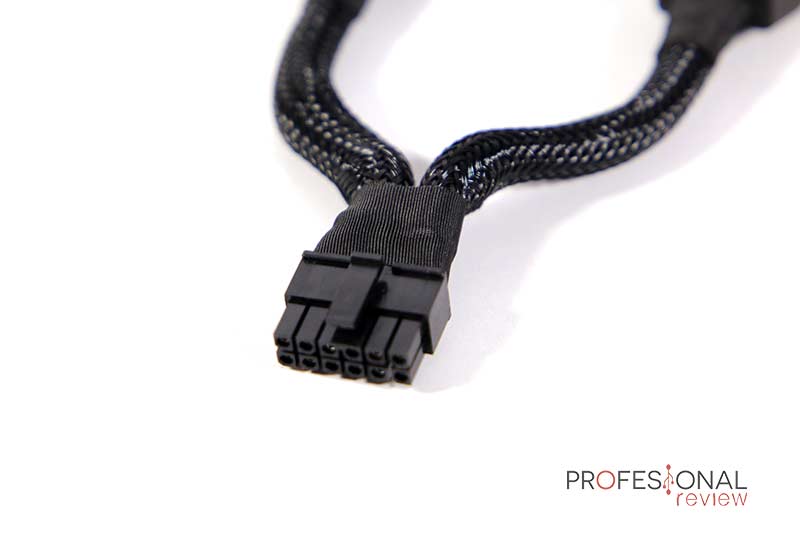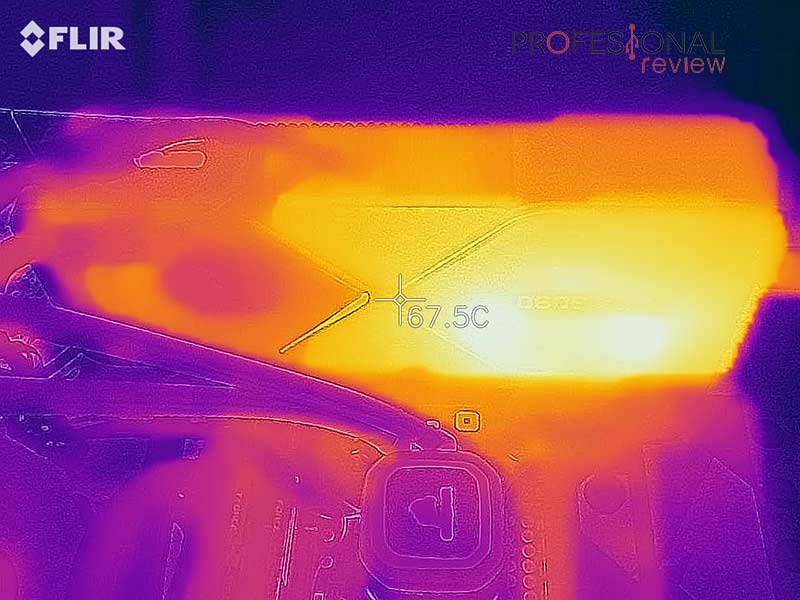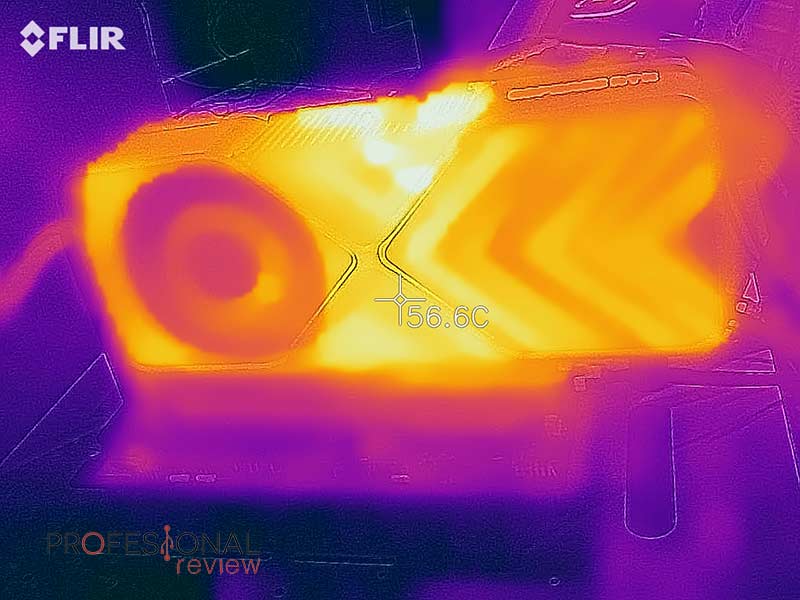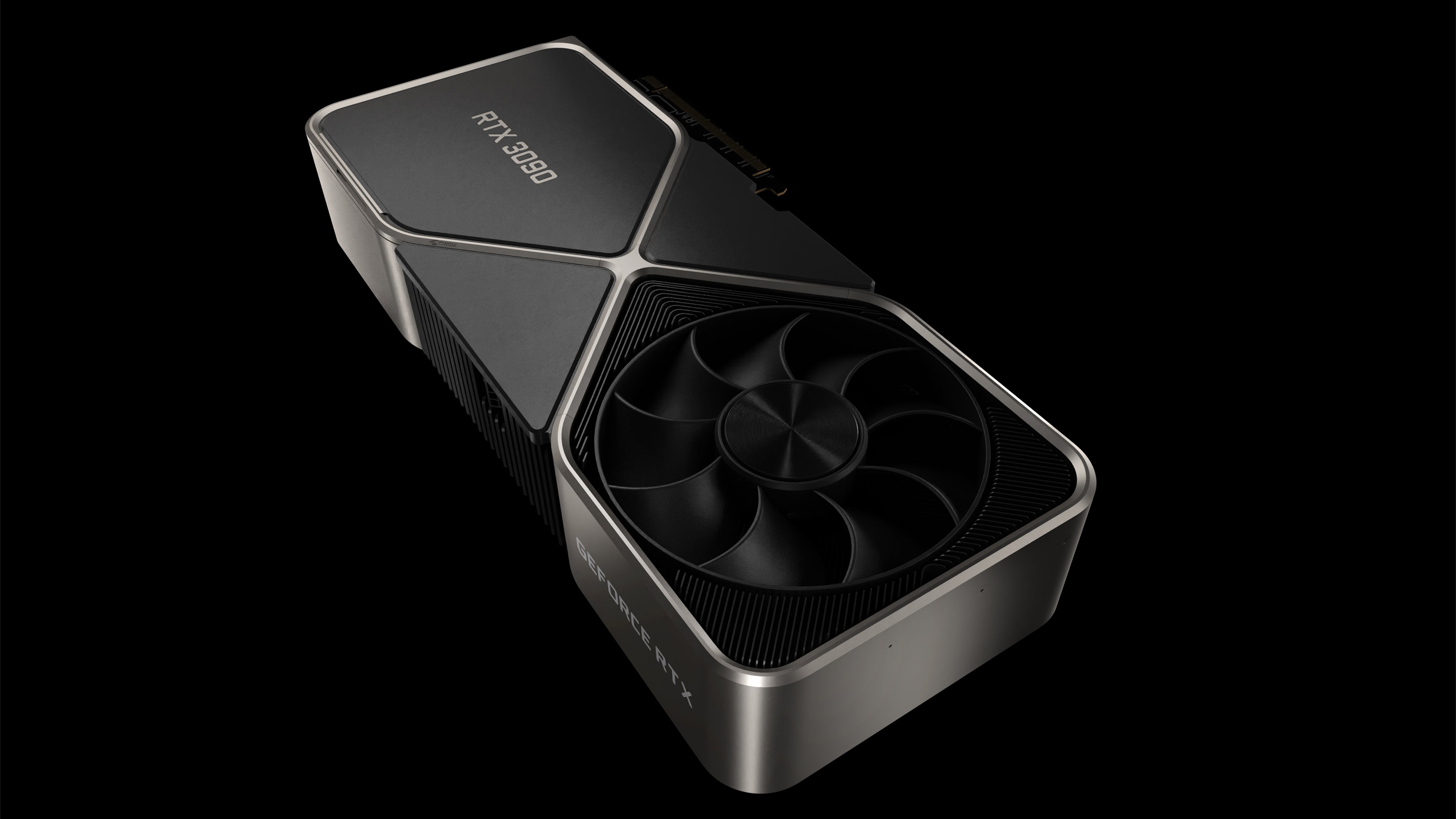
The Nvidia RTX 3090 Founder´s Edition It is the new flagship of the green brand both in the field of video games at 4K and 8K and in design. And they should be proud of that new conceptual aesthetic thanks to a heatsink with fan double-sided giving an aesthetic and wonderful finishes. The evolution in design has been a big step for these proprietary models, and they are closer than ever to custom heatsinks.
This graphics card is mainly aimed at content creators and works in 8K, it does not give up brutal performance in games from 4K with RTX + DLSS. The Ampère architecture and its 10496 Shaders are a record, only within the reach of a future TITAN RTX. We see what this graphics card has in store for us, let's start the analysis!
Before we begin, we must thank Nvidia for trusting us and giving us this card for analysis.
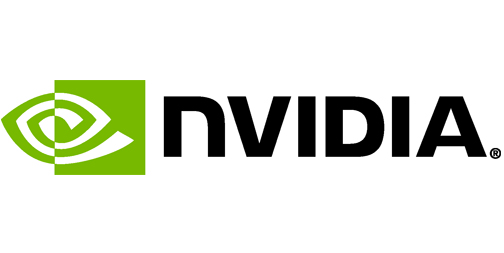
Nvidia RTX 3090 technical characteristics
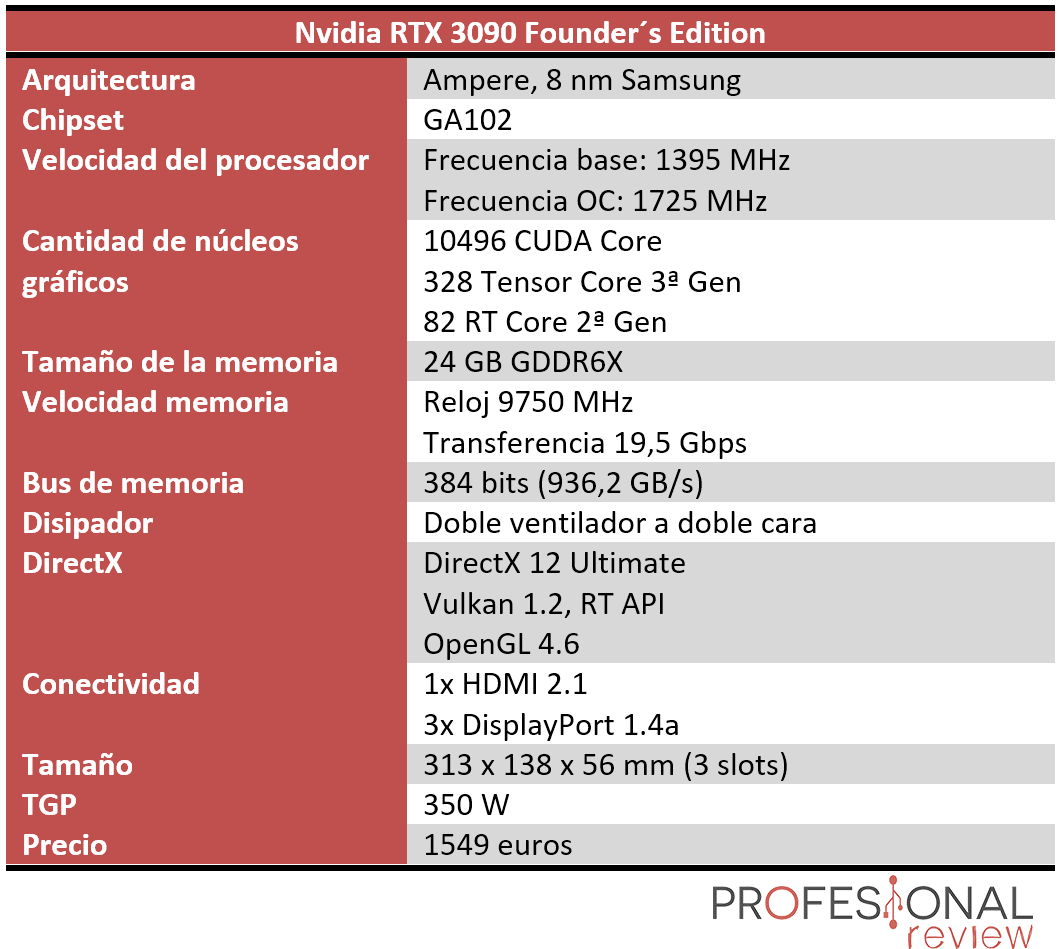
Unboxing
The flagship of the green brand is stomping stronger than ever, and for this a best quality box view on the brand to date. It consists of a container made of solid rigid cardboard of ample dimensions. On the outer faces we do not find any type of card specification, only a refined design based on the corporate colors.
After opening it, we will see a feature similar to the one used by the RTX 3080, with a inclined display for better access. The card will come inside a sandwich-type high-density polyethylene foam mould, so we will have another almost the same in the upper area of the box to prevent the product from moving during transport.

The bundle is composed of the following elements:
- Nvidia RTX 3090 Founder´s Edition graphics card
- 12-pin to 2x 8-pin adapter for power
- Manual and warranty card
We emphasize that this model is going to have the innovative 12-pin power input that the 3080 also implemented. Nor should we worry about having the adapter included in the bundle.
Exterior design with maximum gaming essence
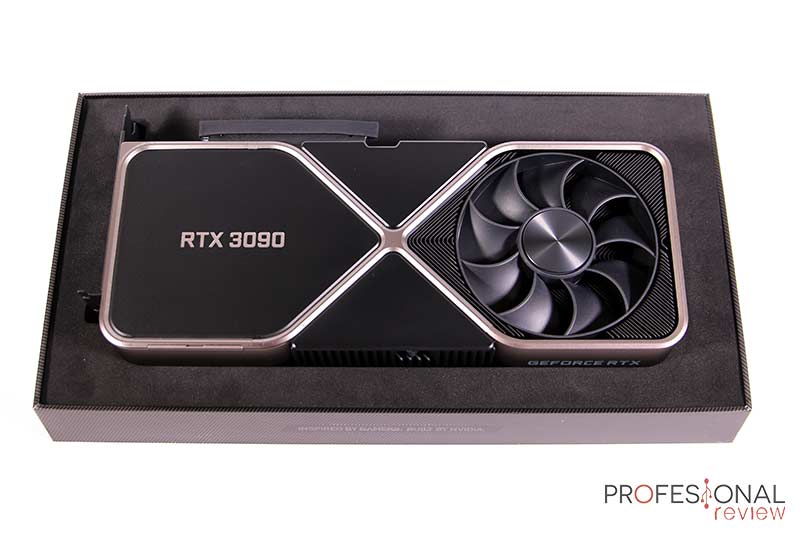
The design concept of this Nvidia GeForce RTX 3090 It coincides with the one that has been chosen for the lower model released just a few days ago. It seems that the more we see her, the more attractive she seems to us, surely due to the fact that it is very different from what we are used to in assemblers.
The main difference between both models is that the size has multiplied considerably, especially in thickness. The measurements are very close to a custom model, with 313mm long, 138mm wide and no less than 60mm thick. Therefore, there will be three slots that this card will consume in our equipment and motherboard, which is really not a small thing. This also shows that Nvidia does not want to risk falling short on cooling capacity.
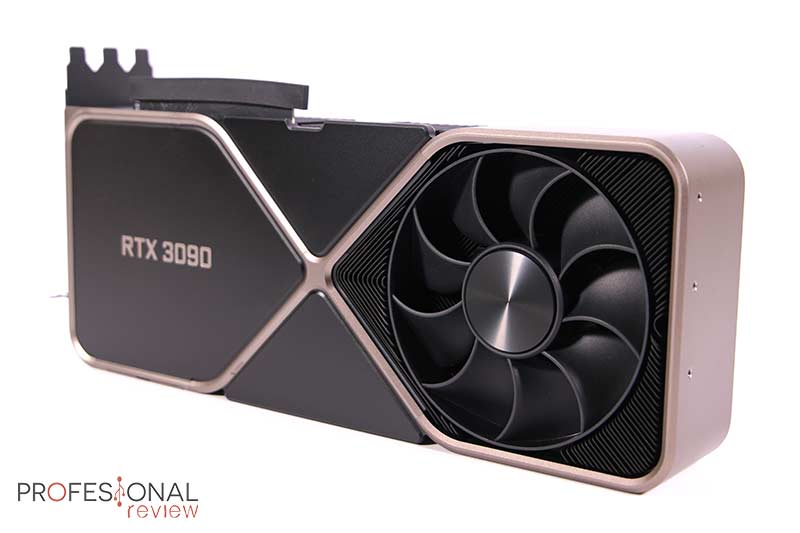
The main structure or that acts as a chassis in the Nvidia RTX 3090 has the peculiar shape of an hourglass. In it we see a perfect union between two or three parts that compose it without using any visible screw. They are made of aluminum in full and proof of this is the considerable weight of this card that will be placed in no less than 2.2kg, An atrocity.
A has been chosen pearly dark gray which is not the natural of aluminum as it was in the previous generation. This improves the aesthetics and gives it a more mystical and premium touch, along with delicate three-sided bezels on all edges. all over the surface a minimally rough finish has been used to dull the shine of the metal a bit, with an “RTX 3090” silkscreen on one edge region.
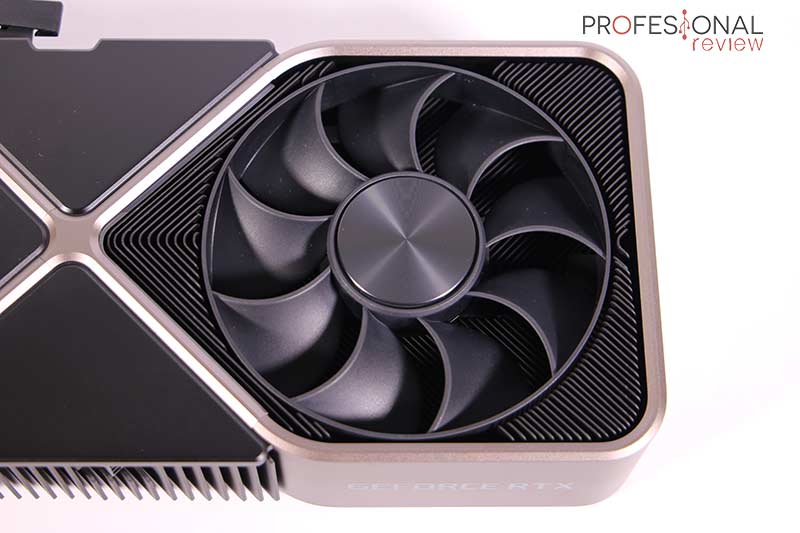
Be careful with them large 100mm fans that have been installed on the Nvidia, because they outperform many present on custom models. This is undoubtedly its most differential aspect, the fact that have a fan on each side. One of the advantages of this is that the card is just as beautiful on the bottom as it is on the top. Although if it weren't for its wide diameter it would be at a disadvantage compared to custom models that almost always have triple fans.
The green mark has done well to implement the semi passive ventilation system by allowing fans to turn off while under low processing load. This will help increase their useful life and not find a very noisy heatsink after a while as it happens with the Founder's Edition RTX 20. The maximum RPM of these fans will be between 2500 and 3000 rpm, so the airflow is going to be pretty forceful.
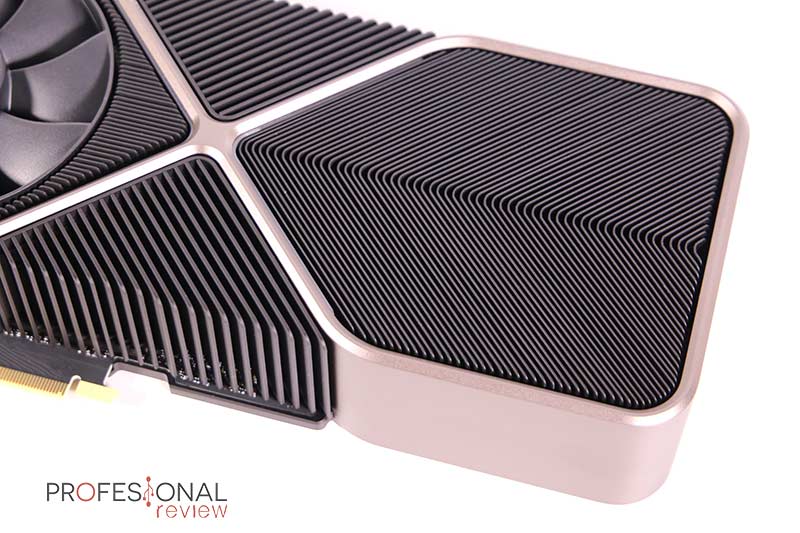
The finned heatsink that forms part of the integral structure of the card is another novelty in the Nvidia GeForce RTX 3090. If we focus on the face that would be in the uppermost or most visible position, we find one half provided with plastic backplatehard. Only the fan part is left visible, thus ensuring a refined look without missing the “RTX 3090” inscription in the center. But this backplate has the function of redirecting the airflow to the outside of the card through the port area, as we will see later.
If we turn it around, we can see much better the finned complex of the heatsink that can be seen in its entirety. In the central area of the cross we have a series of vertical aluminum fins with diagonal orientation and painted black. Their function is to better dissipate the heat that comes out of the chipset area. This lower fan is installed in suction mode.

The end opposite the fan is purely a heatsink block, with the same diagonal fin design, but denser and with thinner elements to increase the air exchange surface. This is where the cold air will enter, and the upper fan placed in extraction mode will send it towards the ceiling of the chassis to be eliminated.
We still have to see the lateral areas of the Nvidia RTX 3090, which in this case are clearly occupied by fins of the heatsink and the walls of that “hourglass” that forms its structure. On the visible side it has the inscription "GeForce RTX" very distinctive of these Founder's, although Nvidia has used white lighting for this new generation. In the central region is the 12 pin power connector, while the front will be totally closed with the two typical holes to fix fastening plates.
Ports and connections
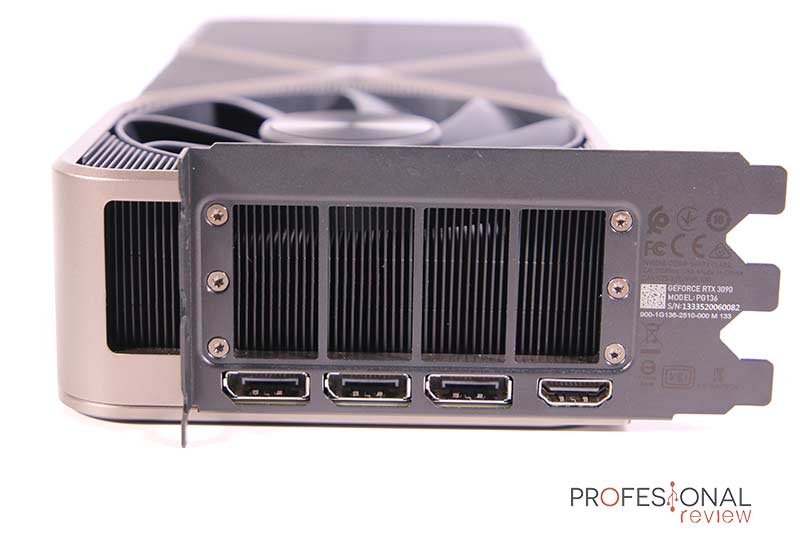
We continue now with the port configuration of the Nvidia RTX 3090, which for the occasion have been implemented a total of four, the maximum capacity of simultaneous connections supported by the card. So we find:
- 1x HDMI 2.1
- 3x DisplayPort 1.4a
To review the capacity of these two interfaces, it will be the HDMI that takes the greatest capacity to finally be 2.1. It supports a maximum resolution of 8K @ 120 Hz in DSC, 4K @ 144 Hz uncompressed, as well as 2K and 1080p both @ 240 Hz. the interface DisplayPort supports up to 8K @60 Hz DSC, 4K @240 Hz, 2K @240 FPS and 1080p @240 Hz and. In all cases it supports HDCP 2.3 for multimedia data protection.
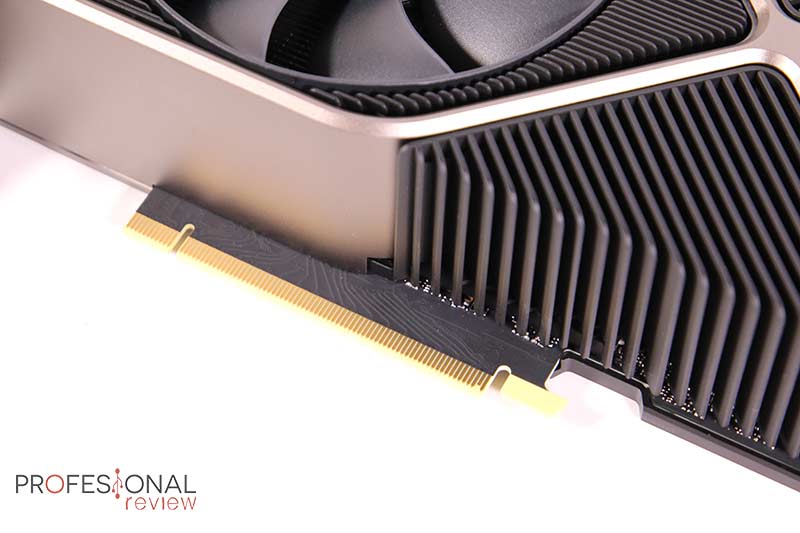
The HDMI video port is not the only novelty in these RTX 30, finally the communication interface is updated to PCIe 4.0 in x16 form factor. In this card it will be especially important because it comfortably supports 8K @ 60 Hz resolutions in HDR10, and using several interfaces at the same time we will put the 32 GB / s duplex bandwidth in trouble.
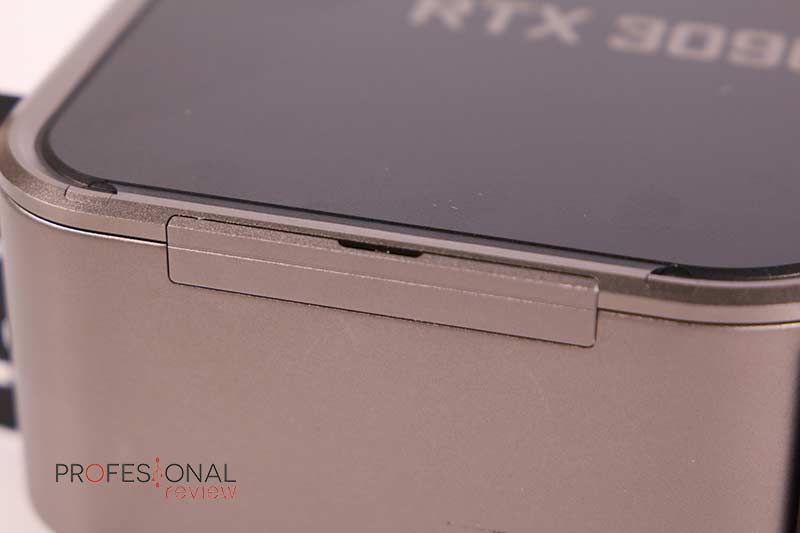
We must add the 2-way NVLink connector, which is present in this 3090 for dual parallel connection. Each link is capable of providing speeds of 14 GB/s in both directions, being able to reach speeds of 112.5 GB/s between the two GPUs.It will be especially interesting for data mining and 8K performance work, since the parallel processing capacity will be used effectively.
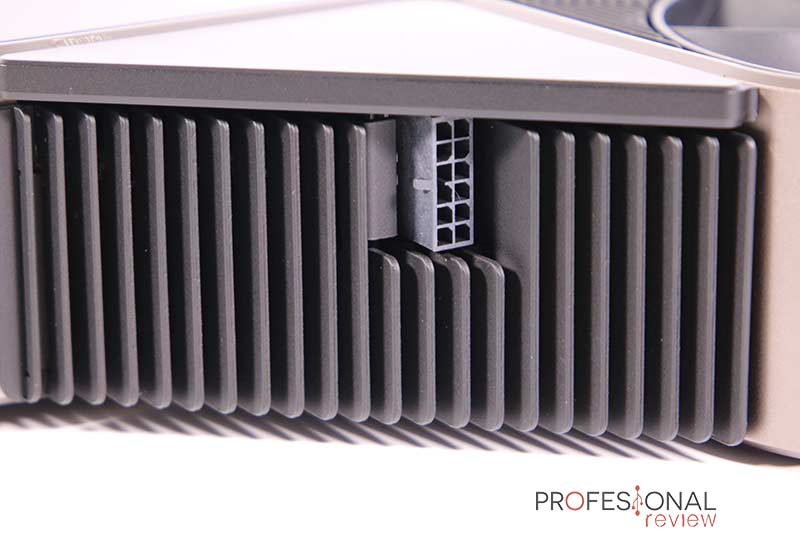
Finally, the power connection of the Nvidia RTX 3090 it is exactly the same as the lower model uses. It is a good way to reduce the space occupied when designing a new 12 pin connector what will he need 8-pin dual-input adapter that Nvidia includes on its card. We don't really like the centralized location of this connector, since it leaves the cables too visible, and in short, they are two large connectors in the way of its beautiful lighting.
Architecture and heatsink of the Nvidia Geforce RTX 3090
We have left some details of the exterior design of the Nvidia Geforce RTX 3090 to deal with them in the specific section of your dissipation system. The manufacturer this time has gone ahead of custom models with a risky concept that is undoubtedly giving very good results. We are not going to remove the heatsink from the PCB because it is quite complicated, and there are also screenshots of his PCB already available.
New heatsink concept
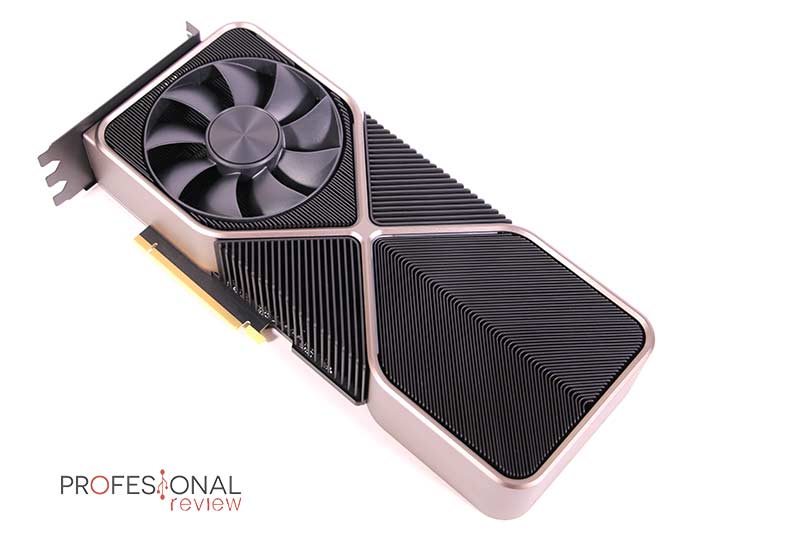
The heatsink, in addition to focusing on its task, which is to cool the GPU, also it is a structural part of the same with that hourglass design, and it will also be the one that gives the aesthetics to the card. For each of the faces of the Nvidia Geforce RTX 3090 we have a fan, so you could say it's a dual fan heatsink really.
This peculiar distribution means that we have two ways of working with the air. The lower face has a fan in suction mode that will put pressurized air on the block in direct contact with the chipset and memories. The back is covered by a plastic semi-backplate, which will force hot air out of the rear port area.
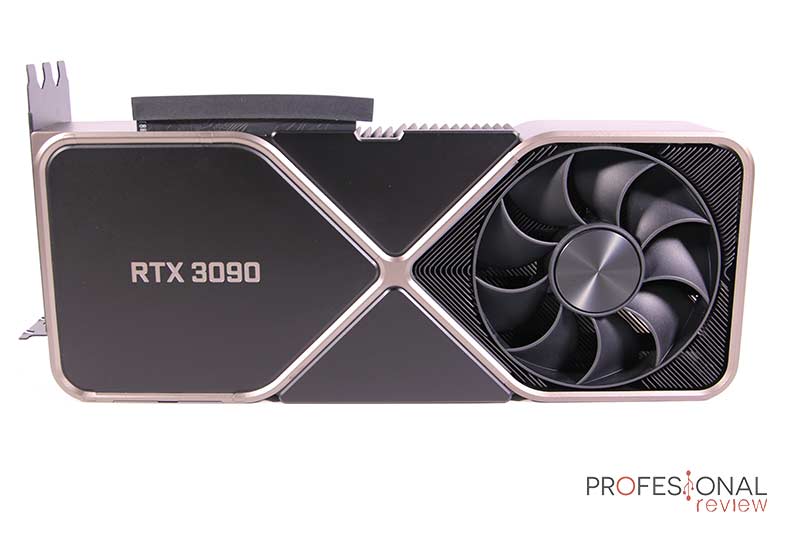
The cold plate in this case it is quite broad and fully made of nickel-plated copper with a steam chamber. Numerous heatpipes come out of it that will transfer the heat to the second block and the passive alloys located in the central part.
On the opposite side that would be visible to the user, we have second fan in extraction mode. The air enters through the lower region that does not have PCBs and exits through the upper region directly towards the upper part of the chassis, thus generating an airflow aided by natural convection. In this way there will be no backplate to accumulate heat in the area, so almost everything is an advantage. Will it improve the temperatures of custom models? We'll see later.
The soap opera of crashes and its solution
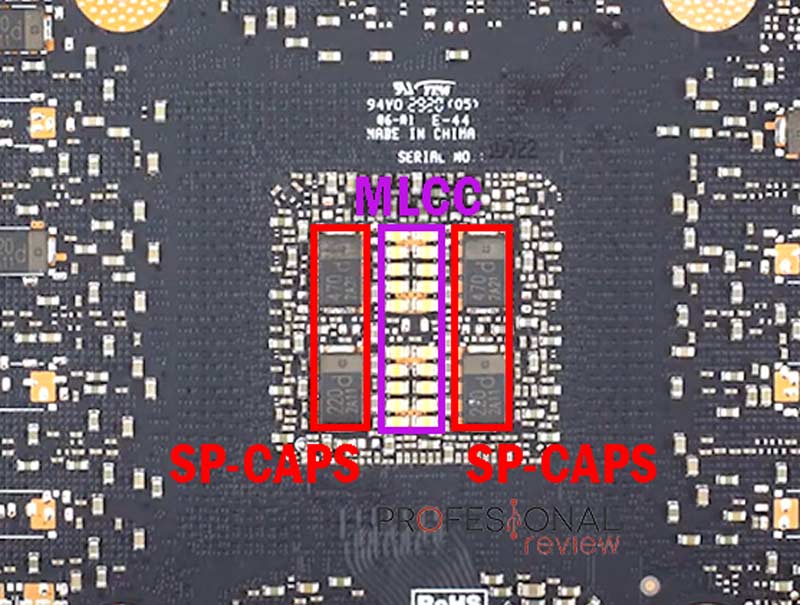
Beneath this massive 3-slot aluminum and copper heatsink we have an incredibly compact PCB packed with 20 power phases, of which 18 of them will be dedicated to the Vcore and another 2 to feed the memories. Nvidia has used a custom PCB for the first time as you can see in its peculiar cut-out and super-compact design.
Much has been said so far about the famous crasheos that some models of these cards were giving, both the RTX 3080 and the RTX 3090. Initially, some media hypothesized that the problems were due to the power filtering capacitors located behind the GPU. More specifically, they blamed the capacitores SP-CAPS and some configurations such as Gigabyte or Zotac that were not used by other type MLCC.
It was observed that the game crashed when the GPU clock exceeded 2000 to 2100 MHz, which was not supported by the SP-CAPS and yes by the MLCC. But after tests were carried out with cards that carried both types of capacitors, it was finally shown that it was not the cause. In fact, we have tested cards with only SP-CAPS like the Gigabyte RTX 3080 Gaming OC and the RTX 3090 EAGLE and they were perfect.
Finally the problem has been solved with the 465.55 drivers, which limit the frequency of these GPUs to less than 2000 MHz, since with any capacitor it could give these problems. Is that a full blown gelding? Yes and no, since in terms of overclocking it could be, but no manufacturer has specified that their cards reach 2000 MHz. If we look at their chips, almost none exceed 1815 or 1875 MHz, so in theory nothing is leaking, since they were not expected to arrive at these watches from the beginning.
Summary: There are no "bad" or "good" capacitors, there are models of higher or lower quality on your PCB, that's always the case. But if your card doesn't have MLCC, it won't crash because of this, and everything you see in other media is fake, and so is claimed by all assemblers.
Characteristics of the Ampere architecture
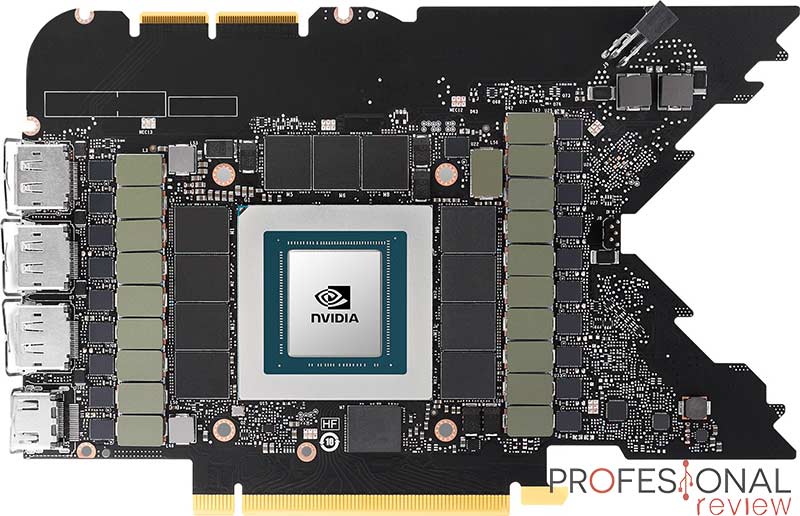
Starring the model Nvidia RTX 3090 Founder´s Edition it is necessary to know a little more in detail the Ampère architecture. The protagonist of this new generation uses a manufacturing process in 8 nm Samsung specially customized to be card-based unlike TSMC's previous FinFETs.
Following improvements to the graphics processing cores and die reduction, Nvidia has improved its performance per watt at up to 1.9 times the previous generation. This does not mean that it consumes less, on the contrary, the TGP of this card is no less than 350W. But the graphics power far exceeds what an RTX 2080 Ti offered and quite a bit what a TITAN RTX did. In the absence of a new model, this RTX 3090 is precisely the new TITAN, aimed above all at designers, creators and miners, more than games.
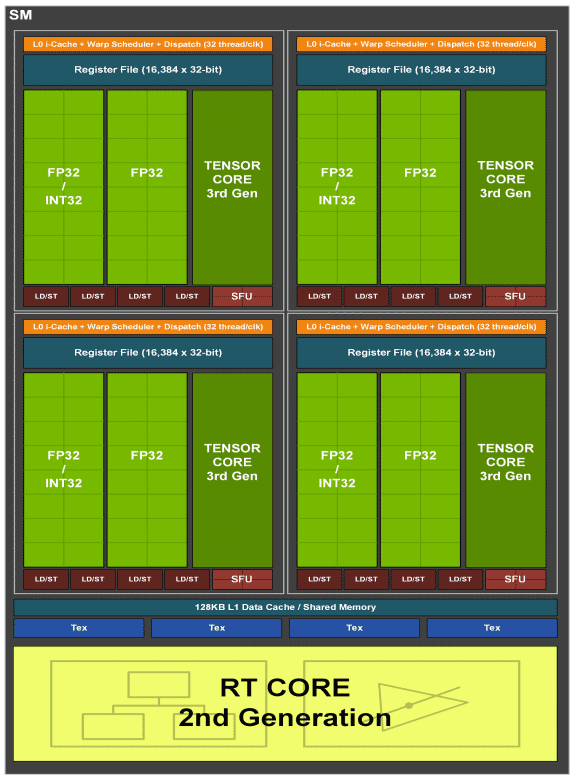
El chipset GA102 from Nvidia RTX 3090 It has an area of 628 mm2 that allows you to host 82 Transmission Multiprocessors (SM). These individual units are in turn made up of three types of processors, 128 CUDA Cores, 4 Tensor Cores and 1 RT Core. The L2 cache increases to 512 KB for each 32-bit memory controller, making a total of 6,144 MB, and the L1 cache amounts to 10,752 MB. The texturing units (TMUs) accounted for are 328, while the rasterizing units (ROPs) will be 112, the highest on a graphics card.
We have a total of 10496 CUDA cores or shaders, an incredible amount also doubling its calculations per cycle with respect to the Turing architecture. These deliver 35.6 Shader-TFLOPS at FP32 compared to 16.3 achieved on the TITAN RTX, thus doubling the capacity. Shaders are dedicated to rasterizing surfaces for those games without Ray Tracing or DLSS.
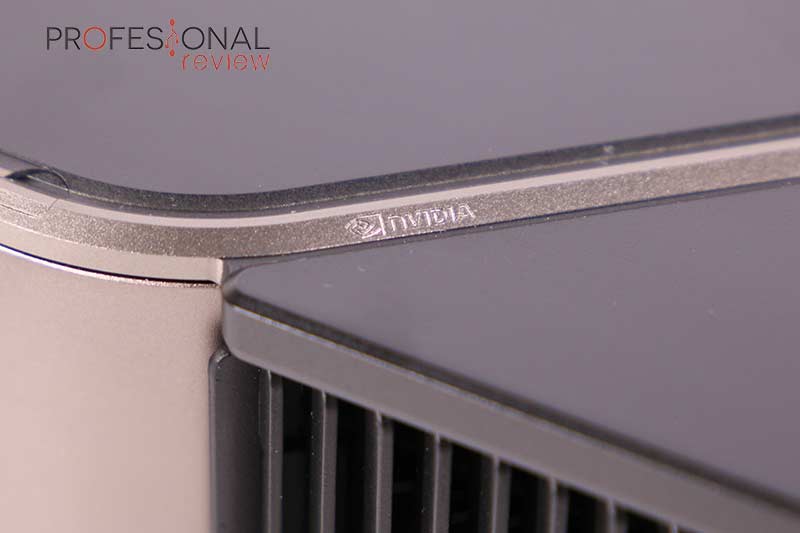
will be 328 3rd generation Tensor Cores implemented in this model, coinciding with the TMUs when dedicated to the texturing of the 3D polygons. They will be in charge of working with DLSS and edge rendering, again doubling the capacity with respect to Turing. The figures they deliver will be 284.7 Tensor-TFLOPS in FP16 compared to 130.5 given by a TITAN RTX. Again we are doubling the processing capacity.
Lastly, the 82 cores RT are dedicated to hardware ray tracing and searching to simulate the real world. Is 2nd generation again it doubles its performance per cycle, although in this case we have an amount that does not double the TITAN RTX, delivering 69.5 RT-TFLOPS compared to 49.2 of the previous model which had 72 RT Cores.
The VRAM memory capacity rises to 24 GB, the same as a TITAN, but becoming tipo GDDR6X. The new chip built by Micron improves the performance of GDDR6 chips by 40%, implementing a new PAM4 operating mode that by pulse modulation allows to work with 2 bits for each clock cycle. The configuration of 12 chips of 2 GB at 32 bits generates a 384 bit bus width, same as the previous model. Its clock frequency goes up to the 9750 MHz in this model to give us speeds of 19.5 Gbps, as well as a bandwidth of 936.2 GB/s.
Nvidia's own functions for its cards
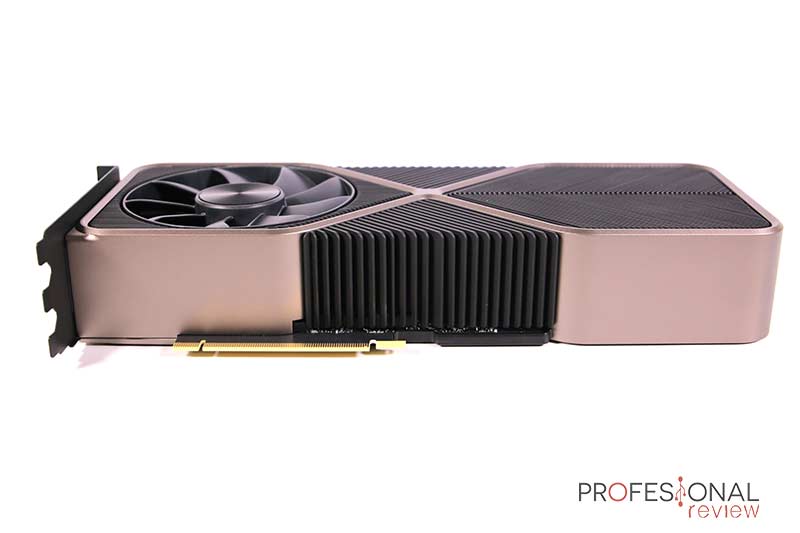
As we have mentioned several times, we must be clear that this Nvidia RTX 3090 It is not a typical gaming model even though it is listed as such. Its processing capacity goes a little further and It will be used to the maximum in rendering tasks and work in 8K resolution. Although it is the only graphics card that allows us to play on 8K resolution with DLSS at 60 FPS in certain games. In 4K it will also mark distances with the RTX 3080, which is much more for gaming, but in Full HD it will be completely wasted.
It will be very interesting for this the new functions that it offers us Nvidia Studio y Nvidia Broadcast. The card will be able to detect you and your chair to intelligently remove all the background behind it through a camera. The new hardware acceleration implemented for blur of movement with Ray Tracing it will be 5 times faster than in Turing. The performance in creator programs will be the final.
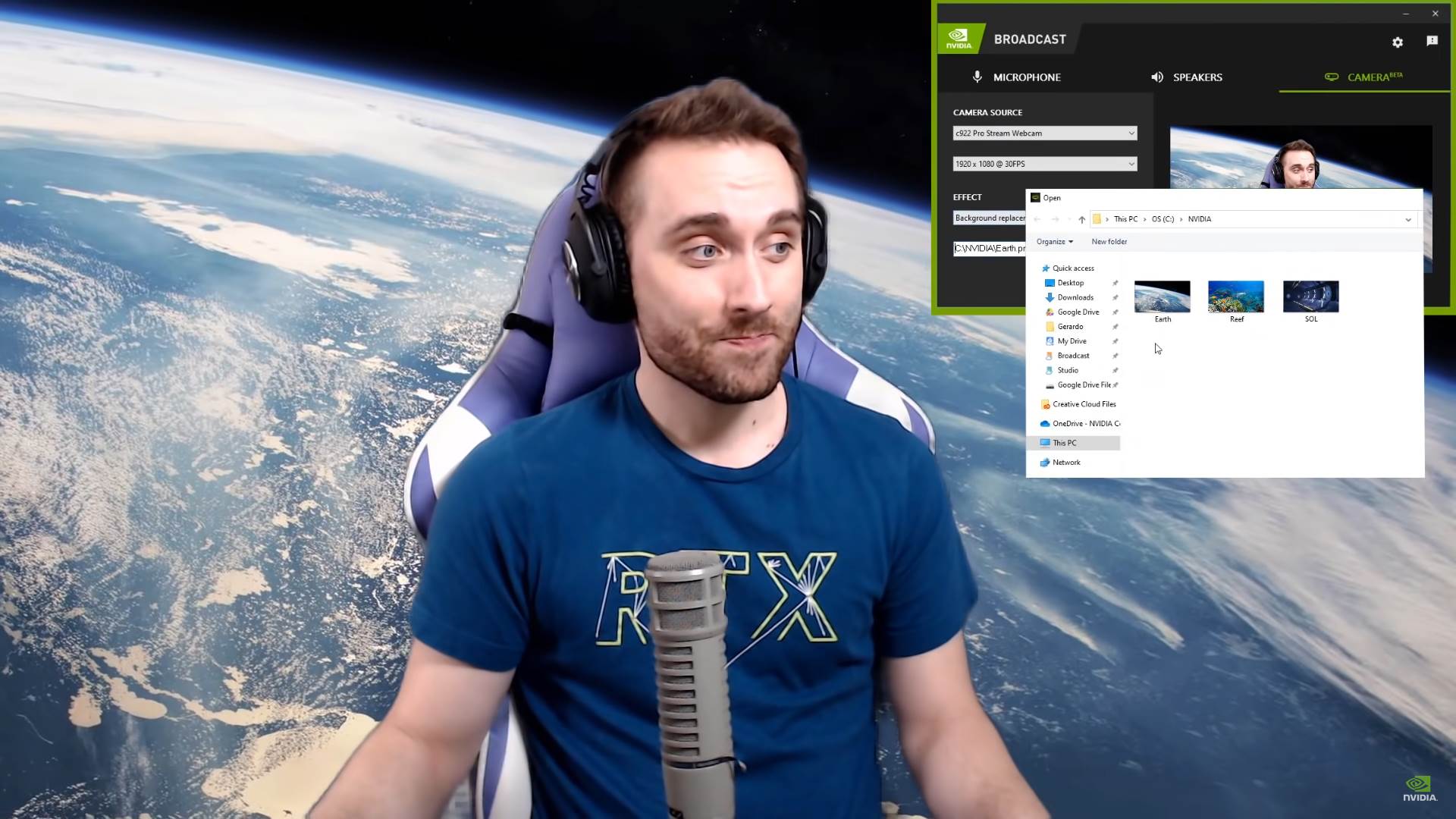
This card has proven to be almost 3 times faster in DaVinci project rendering and almost 20% faster than an RTX 2080 Ti in Blender. An extremely interesting feature for design and gaming is the creation of the RTX IO API, which sends graphic information directly to the GPU and memory without going through the CPU and RAM. This makes the transfer 100 times faster than a Gen4 SSD and makes the CPU work 20 times less.
Test bench and performance test
We reached the peak of the analysis and performed all the performance tests at the Nvidia GeForce RTX 3090. For this we have used the same tests and games as for the rest of the cards. Our test bench is as follows:
|
RUEBAS |
|
|
Processor: |
Intel Core i9-9900K |
|
Base plate: |
Asus Maximus Formula XI |
|
Memory: |
G.Skill Trident Z Neo RGB 16GB@3600 MHz |
|
heatsink |
Corsair H100i RGB Platinum SE |
|
HDD |
Samsung 860 QVO |
|
Graphic card |
Nvidia GeForce RTX 3090 |
|
Power supply |
Cooler Master V850Gold |
|
Monitor |
Viewsonic VX3211 4K mhd |
All tests and synthetic tests have been performed with the default configuration of each program. The tests consist of tests that are executed on the resolutions Full HD, 2K y 4K. We have executed all of them on the operating system Windows 10 Pro in its 2004 version fully updated and with GeForce drivers also in its latest version 456.55.
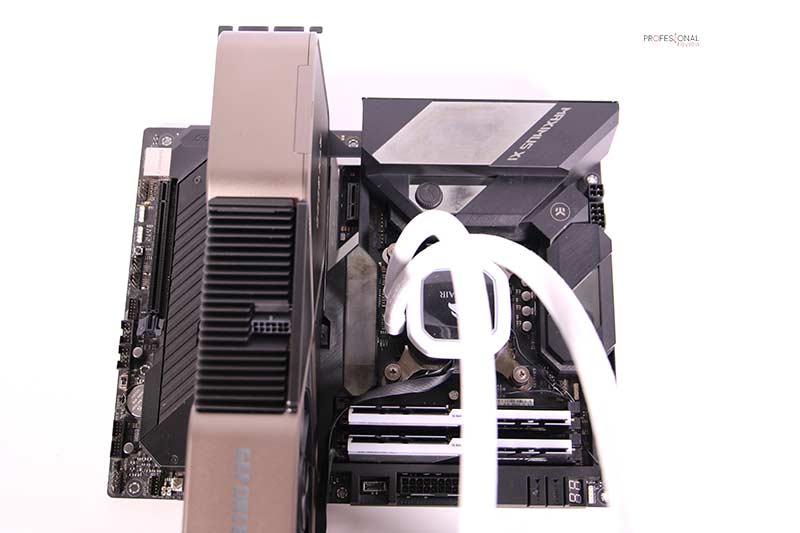
The playability of a graphics card could be assessed in the following steps depending on the framerate it delivers:
| FRAMES PER SECOND | |
| Frames Per Second (FPS) | gameplay |
| Less than 30FPS | Injugable |
| 30 ~ 40 FPS | playable |
| 40 ~ 60 FPS | Good |
| Greater than 60 FPS | Really good |
| Greater than 144 Hz | Realist |
Benchmarks
For the benchmark tests We will use the following programs and tests:
- 3DMark Fire Strike, Ultra y Extreme
- Time Spy normal y Extreme
- Port Royal
- VRMARK Orange Room
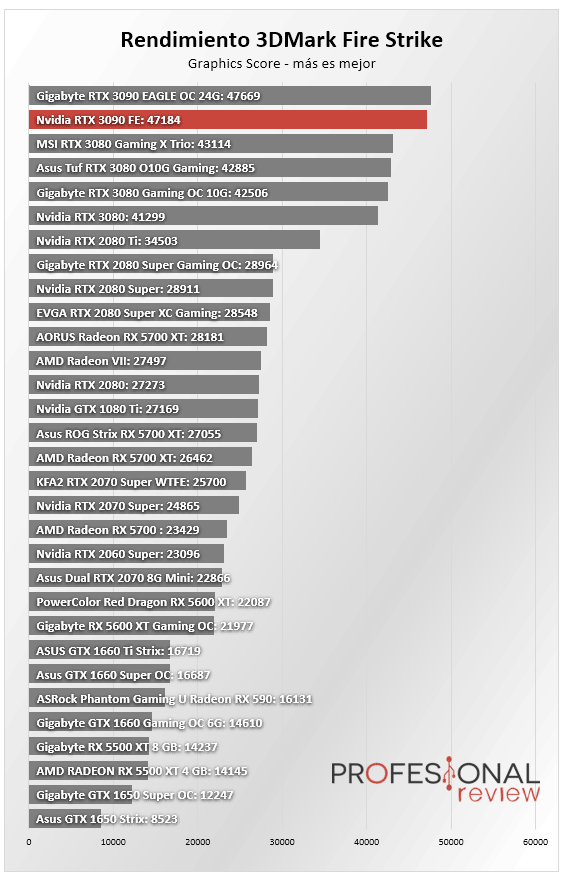
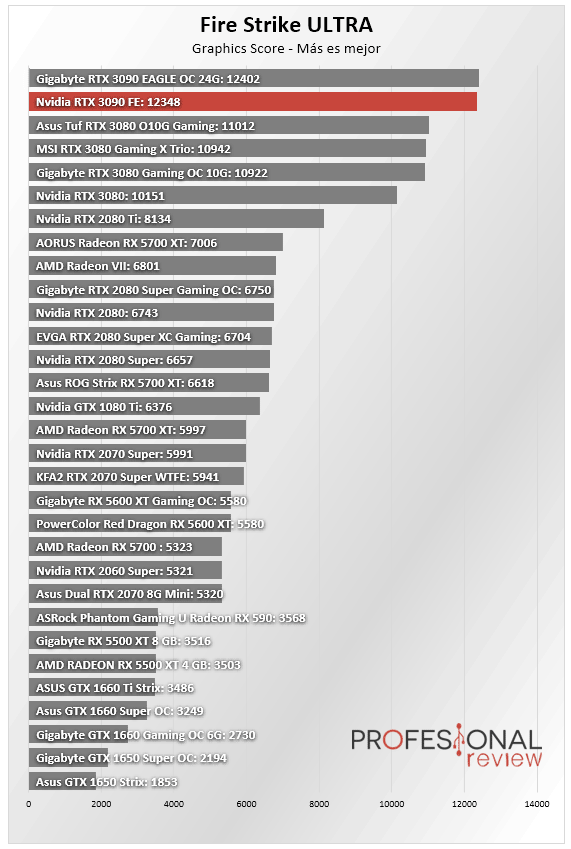
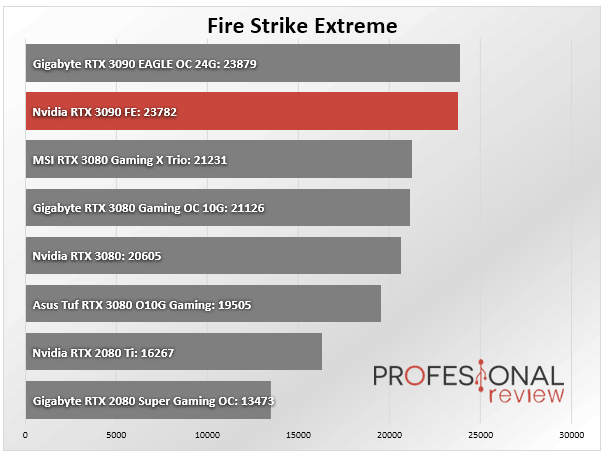
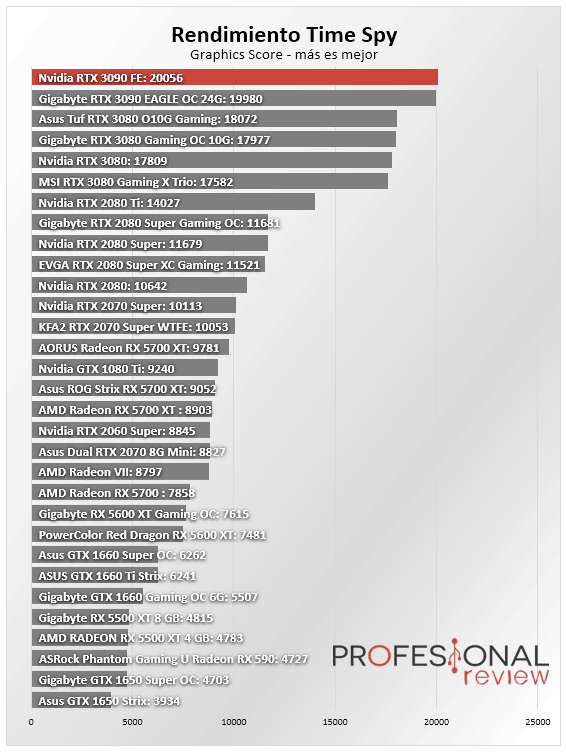
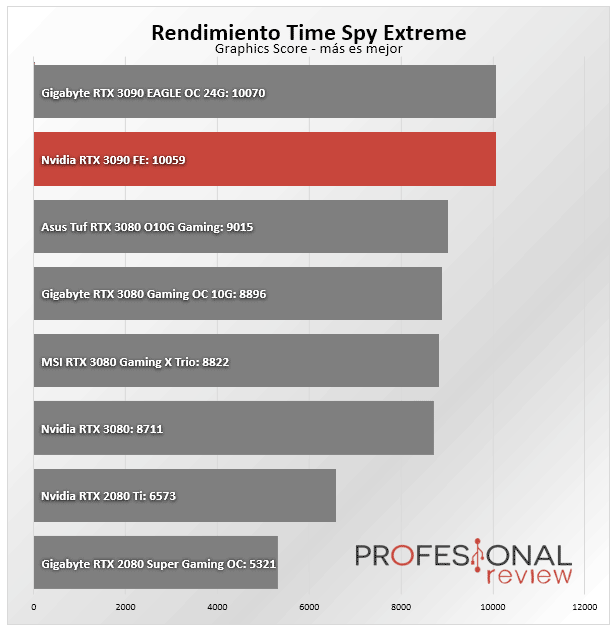
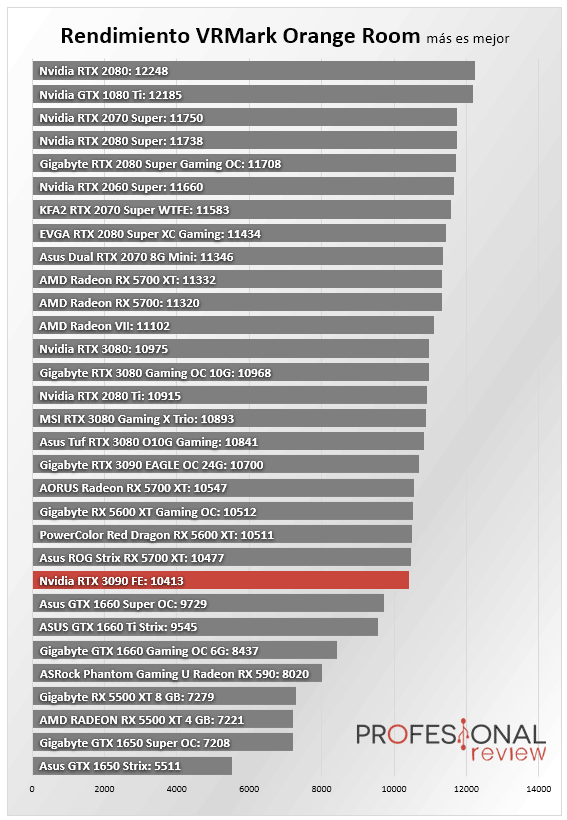
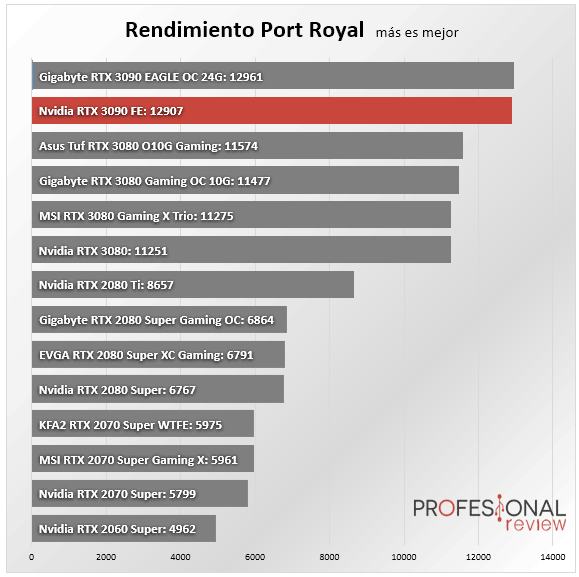
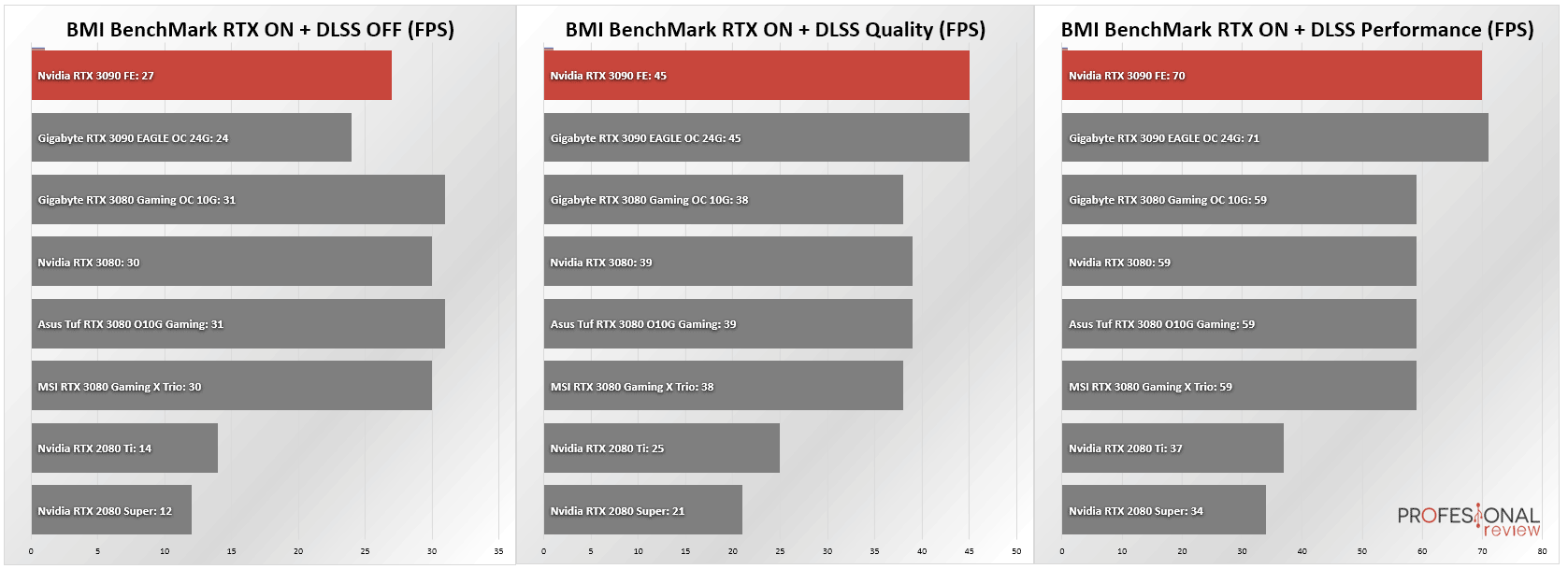
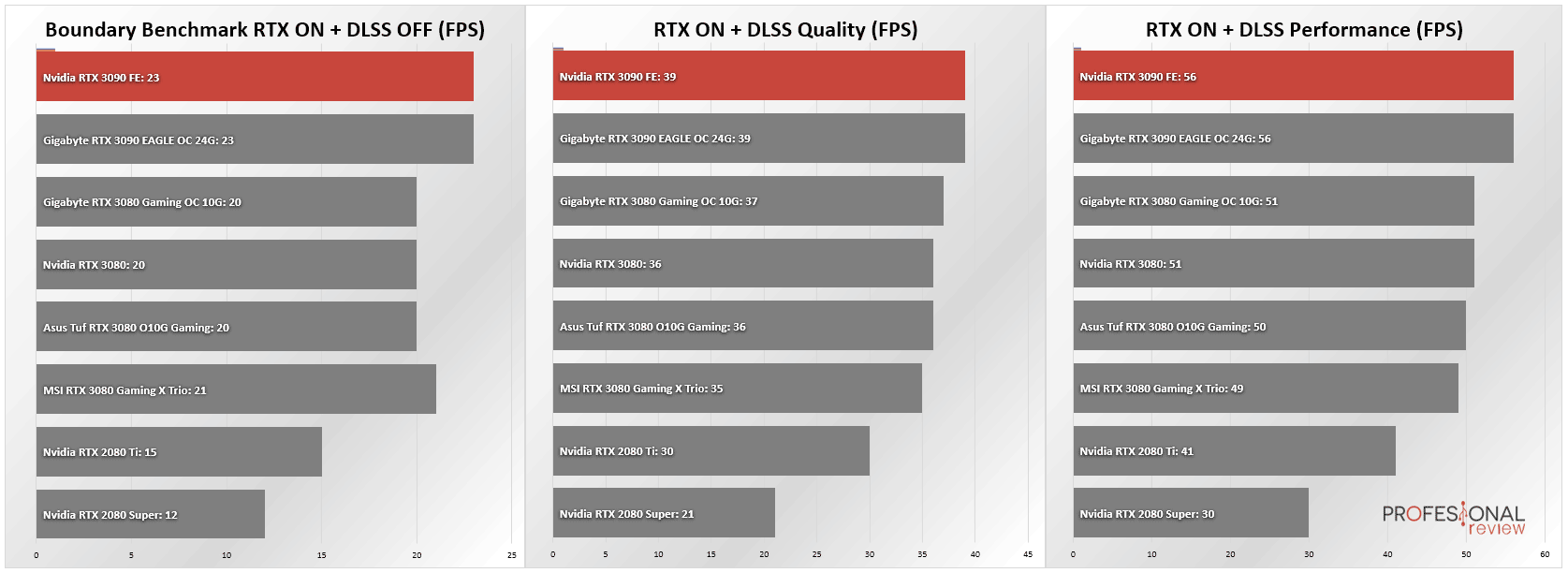 The figures show us a performance practically traced to the model assembled by Gigabyte, until now our only reference in the test field. At least when it comes to performance in benchmarks, with the new drivers that eliminate possible stability problems we have no differences.
The figures show us a performance practically traced to the model assembled by Gigabyte, until now our only reference in the test field. At least when it comes to performance in benchmarks, with the new drivers that eliminate possible stability problems we have no differences.
Rendering and performance tests
Since it is a graphics card primarily intended for creators whose strength is multiprocessing and rendering capabilities, we have tested its performance in three widely used programs. They will be these:
- Blender 2.9 + proyecto The Junk Shop
- OTOY OctaRender + benchmark
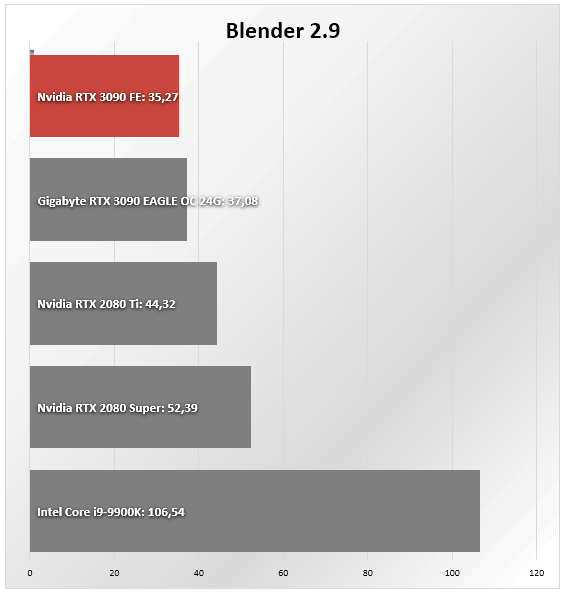
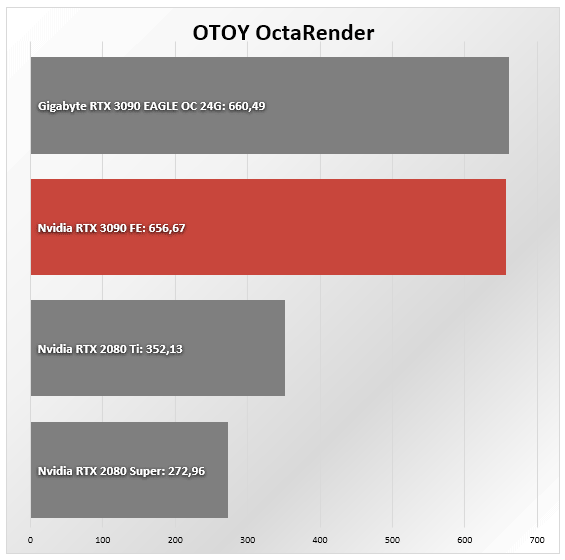
game testing
Let's evaluate the actual gaming performance, thus having a more palpable proof of what this Nvidia GeForce RTX 3090 will be able to deliver under the different APIs that each game uses.
We are going to carry out the tests in the resolution 4K (3840 x 2160p), since it is mainly oriented to work on it. We will have a full range of results so we can compare them to other GPUs. For each of the games, we have kept the high quality settings in all three resolutions.
- Shadow of the Tomb Rider, Alto, TAA + Anisotropic x4, DirectX 12
- Far Cry 5, Alto, TAA, DirectX 12
- DOOM 2016, Ultra, TAA, Open G.L
- Final Fantasy XV, standard, TAA, DirectX 11
- Deus EX Mankind Divided, High, Anisotropic x4, DirectX 12
- Metro Exodus, Alto, Anisotropico x16, DirectX 12 (sin RT)
- Control, High, no RTX, 1920x1080p rendering, DirectX 12
- Gears 5, Alto, TAA, DirectX 12
- Red Dead Redemption 2, Alto, Anisotropico x16, DirectX 12
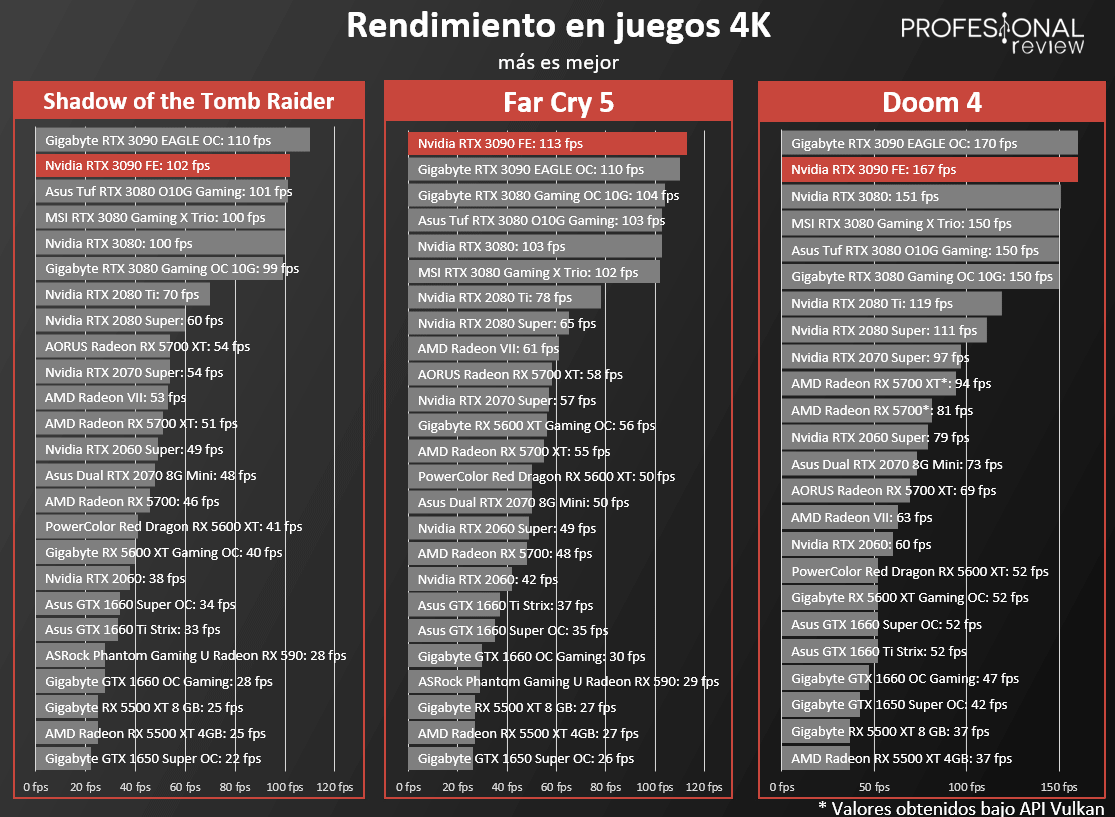
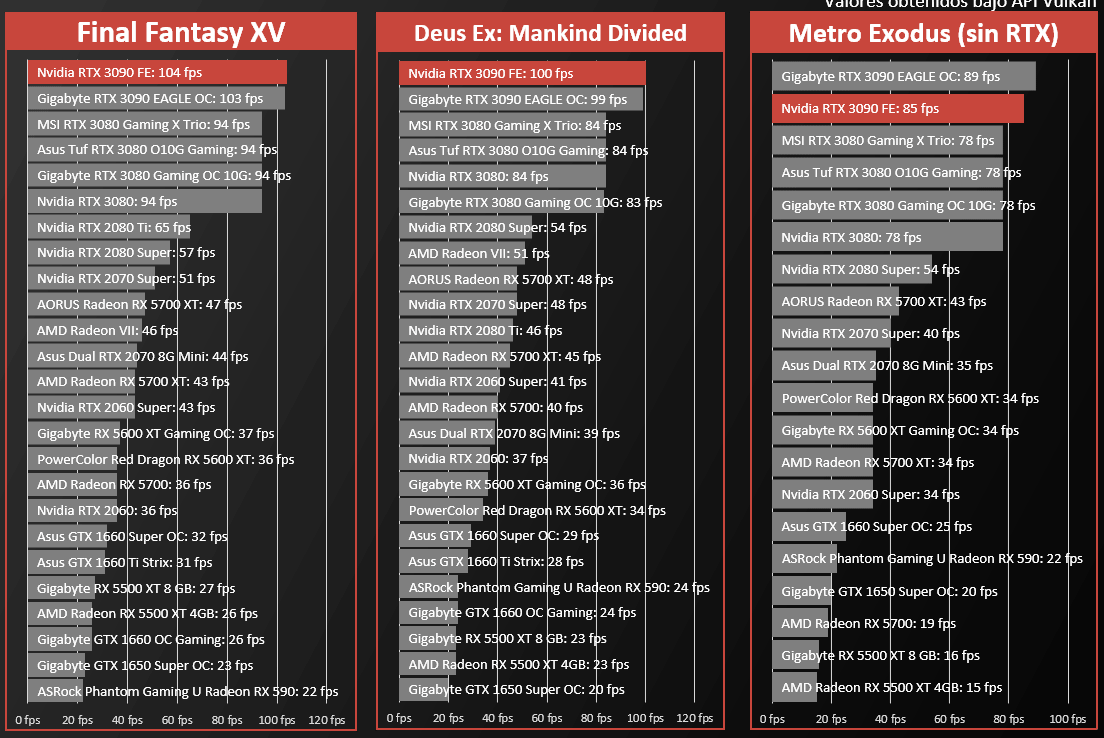
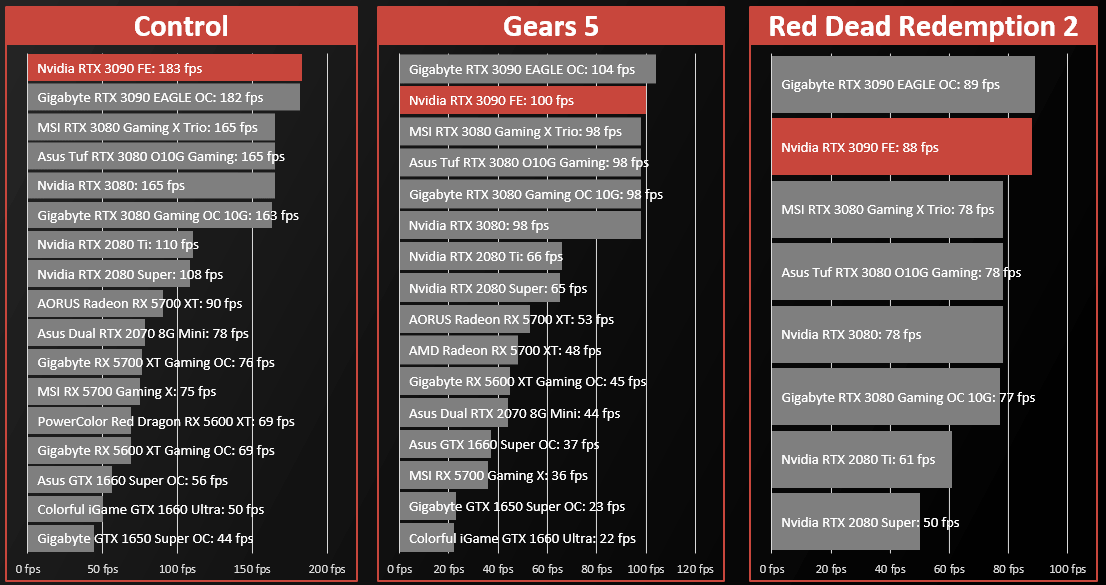
We discarded the 1080p and 2K tests for the fact of having obtained better results in the RTX 3080. The power of this card is noticeable above 4K, and therefore the most interesting results will be for it. And what we see again it is similar to that measured on the Gigabyte card.
Here we do notice certain performance changes that are surely due to the drivers, since the working frequency is similar on both cards. Those who have been worst affected by the update are Tomb Raider, Metro and Gears 5, which honestly is not a novelty due to its arbitrariness in performance. In the others we see very similar results, although we expected a little more.
Testing in games with Ray Tracing
We are going to test the Ray Tracing and DLSS performance with the following games in 4K and 8K resolution this time. For the 8K tests we have lowered the graphic quality a bit.
- Metro Exodus, RT High, DLSS, Anisotropic x16, DirectX 12 (Low in 8K)
- Shadow of the Tomb Rider, RT and DLSS, TAA + Anisotropic x4, DirectX 12 (Low in 8K)
- Control, RT Alto, DLSS a 1080p, DirectX 12 (Medio en 8K)
- Call Of Duty, RT High, DLSS, 1080p rendering, DirectX 12 (High 8K)
- Wolfenstein Youngblood, RTX High, DLSS performance, Vulkan (Medium at 8K)
- Battlefield V, RTX High, DLSS (at 4K), DirectX 12 (Medium at 8K)
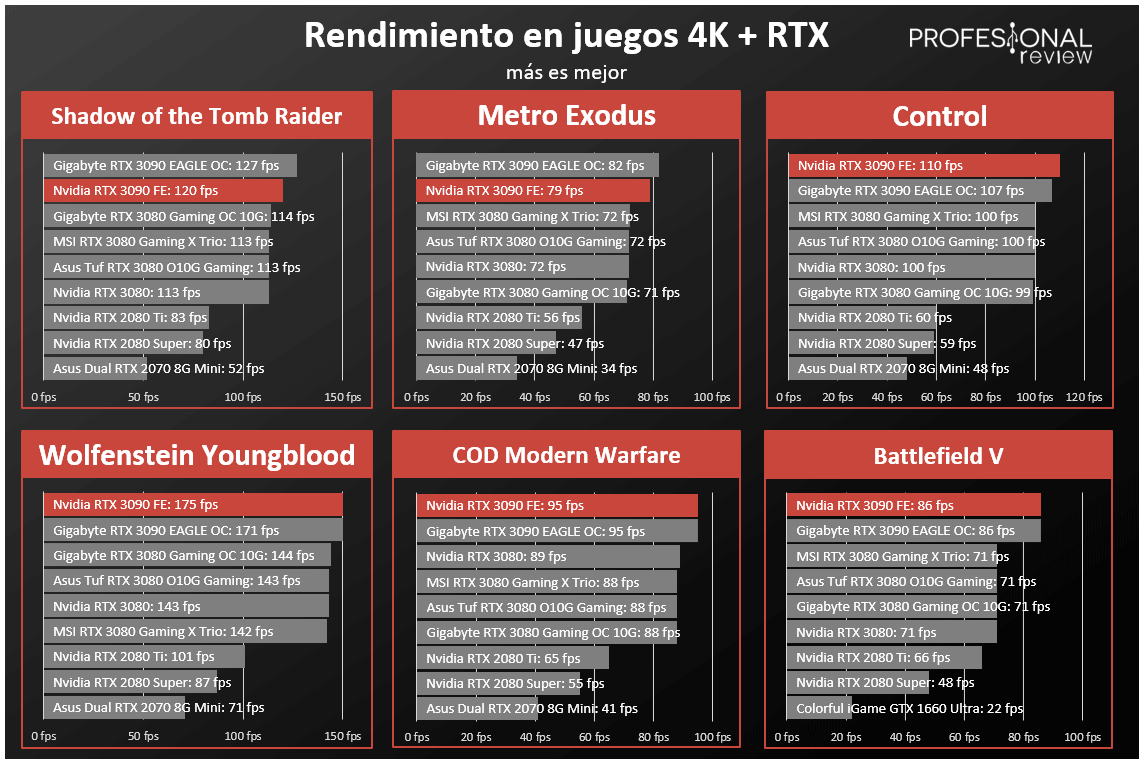

Again in this test we obtain results almost traced to the other tested RTX 3090 models, only in Control we have obtained performance improvements up to the 110 FPS and 4K. Again in Tomb Raider and Metro we have worsened some FPS.
At 8K we get results that They range from 40 FPS to 111 Call of Duty. In some cases it will be possible to get some FPS improvements if we lower the Ray Tracing or render resolution, but we have chosen parameters that give a good experience as well as graphic quality. What is clearest is the great performance saint compared to the RTX 2080 Ti, in which the playable experience was totally unfeasible.
Overclocking
Let's overclock this Nvidia GeForce RTX 3090 to see how far we can go with this 8nm Samsung chipset and GDDR6X. For this we have used MSI Afterbuner for its ease of use. In this way we have carried out a new test in 3DMark Fire Strike and new tests Shadow Of The Tomb Raider in all three resolutions.
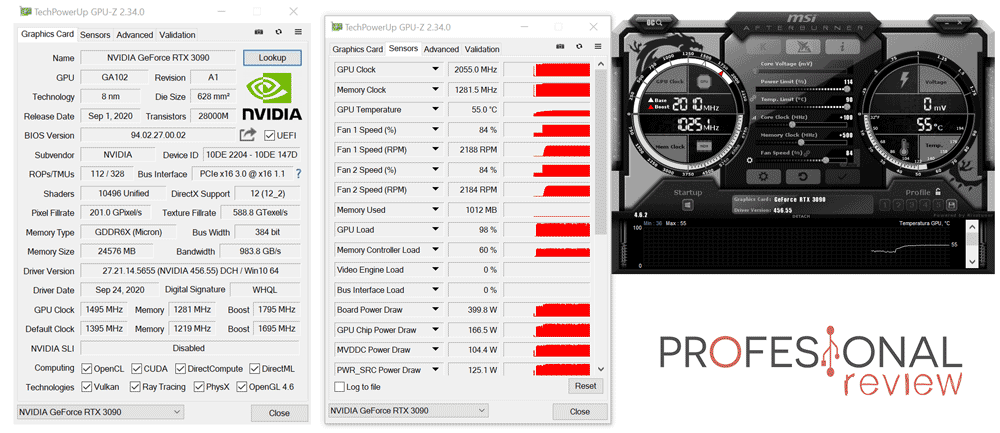
| Shadow of the Tomb Rider | Stock | @ Overclock |
| 1920 x 1080 (Full HD) | 157 FPS | 154 FPS |
| 2560 x 1440 (WQHD) | 149 FPS | 150 FPS |
| 3840 x 2160 (4K) | 102 FPS | 109 FPS |
| 7680 x 4320 (8K) + DLSS | 44 FPS | 47 FPS |
| 3DMark Fire Strike | Stock | @ Overclock |
| Graphics Score | 47184 | 42640 |
| Physics Score | 21292 | 22615 |
| Combined | 30549 | 29862 |
despite the alleged frequency limitations, we have managed to get a good 100 MHz to the GPU clock and another 500 MHz to the memories. Thus we reach 2050 MHz with a 114% supercharging, significantly improving FPS in the test performed. It will be 7 FPS in 4K and up to 3 in 8K, which is a lot if we consider the high working resolutions. In FHD and 2K the results are quite irrelevant if not bad.
temperatures and consumption
We have stressed the Nvidia GeForce RTX 3090 for a few hours while we monitored their temperatures and consumption. We have used as FurMark for stress and HWiNFO to view the telemetry, along with a watt meter which measures the power of the entire computer except the monitor. The ambient temperature in the room will be 24OC.
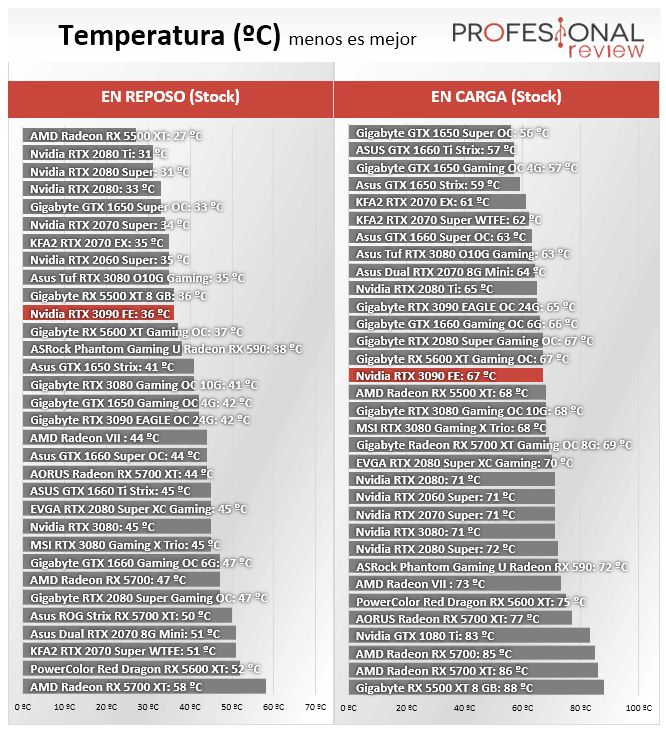
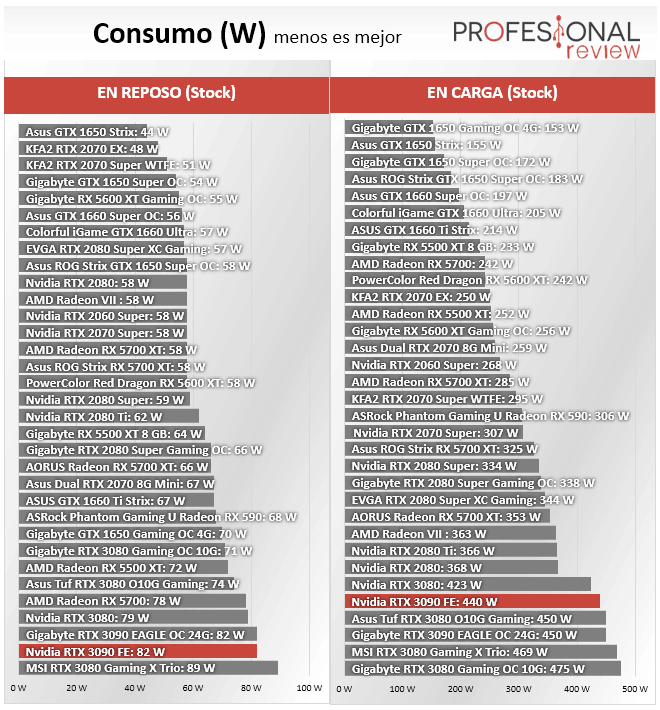
Here we do not find any surprise, as far as consumption is concerned, being practically the same in the two RTX 3090 listed. In terms of temperatures, we have a very good heatsink, staying very close to the custom models in medium temperatures under stress. Very good job of Nvidia in this aspect.
Final words and conclusion about the Nvidia GeForce RTX 3090
The general conclusion that we can draw about the reference model released by Nvidia is that offers a performance practically mirrored to the assembled versions from other manufacturers. If we take into account that the price is generally lower, It will make an excellent purchase option.
And it is that Nvidia has pulled out of the sleeve a heatsink very different from what we had seen so far and Also, it performs very well.. Using a unique double block configuration with double sided fan and no less than 110 mm, temperatures under stress are excellent. The fans normally working at half capacity, so the room for improvement we have is wide, although at Full they generate quite a bit of noise.
Visit our guide to the best graphics cards on the market
Gaming performance remains relatively arbitrary depending on the tested title and its resolution. It comes in handy for some like Red Dead Redemption, and for others fatal like Tomb Raider. In these extremely powerful models for something similar to the AMD Threadripper, there will be games that adapt and others that do not. What is clear is that its optimal use is from 4K, and very focused on designers, rendering and GPU computing and not much on gaming.
Overclocking this time is pretty good, even better than in the RTX 3080 that we have tested With permission from the recent driver update. we have achieved get 2050 MHz core frequencies Y up to 7 FPS in 4K and 3 in 8k, which is enough.
The Nvidia GeForce RTX 3090 is available for a price of 1549 euros, which is at least 50 euros cheaper than the cheapest custom models. It is indeed a very important leap compared to the RTX 3080, but it is much better than what was seen in the previous generation, with the RTX 2080 Ti and especially the TITAN RTX. Taking this into account, Nvidia has adjusted its price a lot, and will be the best there is on the market for creators. Meanwhile the RTX 3080 will be the best for gaming.
|
ADVANTAGE |
DISADVANTAGES |
|
+ PREMIUM AESTHETICS |
– STILL NEEDS TO POLISH THE DRIVERS TO HAVE GREATER OPTIMIZATION IN GAMES |
| + HIGH PERFORMANCE HEATSINK | |
|
+ IMPRESSIVE GROSS YIELD |
|
|
+ IDEAL FOR WORK IN 4K AND 8K WITH 24 GB OF VRAM |
|
|
+ PRICE MORE ADJUSTED THAN IN ASSEMBLERS |


 Discounts
Discounts
